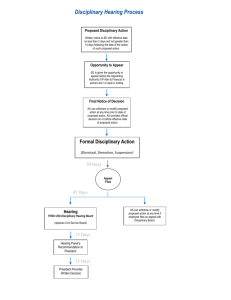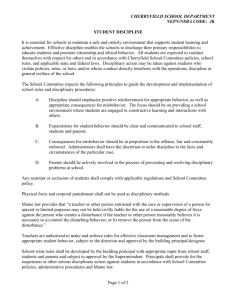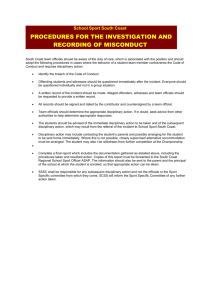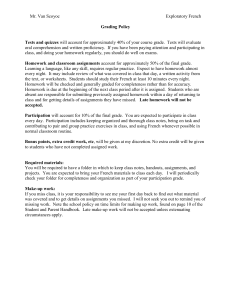Disciplinary Procedure - Guidance for Managers
advertisement
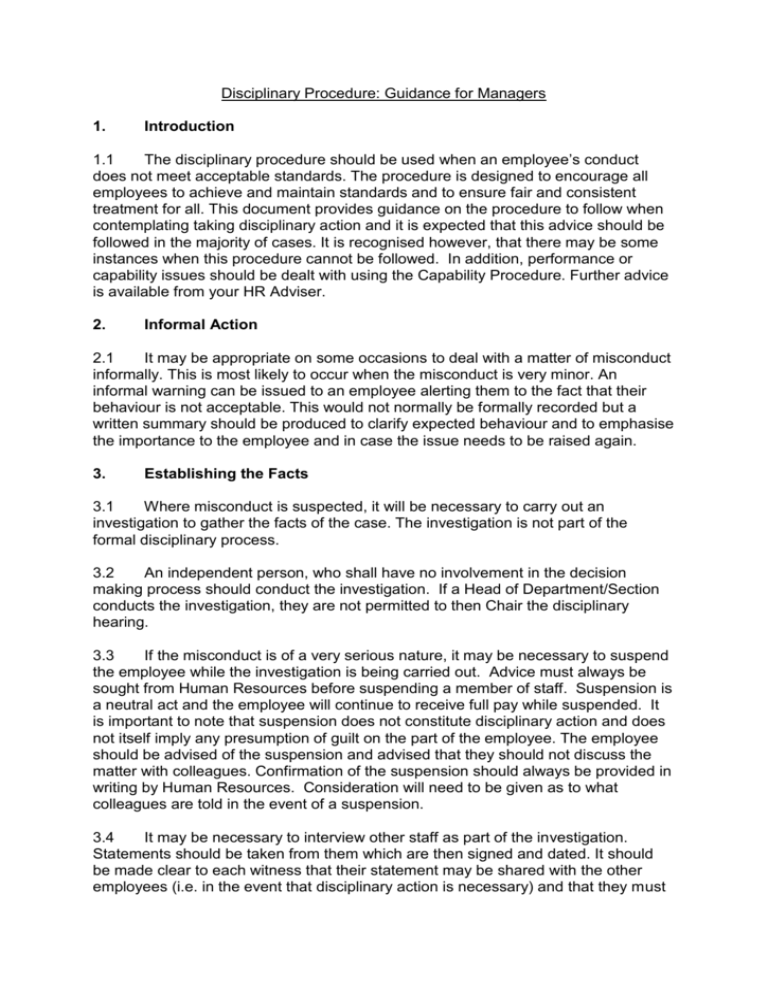
Disciplinary Procedure: Guidance for Managers 1. Introduction 1.1 The disciplinary procedure should be used when an employee’s conduct does not meet acceptable standards. The procedure is designed to encourage all employees to achieve and maintain standards and to ensure fair and consistent treatment for all. This document provides guidance on the procedure to follow when contemplating taking disciplinary action and it is expected that this advice should be followed in the majority of cases. It is recognised however, that there may be some instances when this procedure cannot be followed. In addition, performance or capability issues should be dealt with using the Capability Procedure. Further advice is available from your HR Adviser. 2. Informal Action 2.1 It may be appropriate on some occasions to deal with a matter of misconduct informally. This is most likely to occur when the misconduct is very minor. An informal warning can be issued to an employee alerting them to the fact that their behaviour is not acceptable. This would not normally be formally recorded but a written summary should be produced to clarify expected behaviour and to emphasise the importance to the employee and in case the issue needs to be raised again. 3. Establishing the Facts 3.1 Where misconduct is suspected, it will be necessary to carry out an investigation to gather the facts of the case. The investigation is not part of the formal disciplinary process. 3.2 An independent person, who shall have no involvement in the decision making process should conduct the investigation. If a Head of Department/Section conducts the investigation, they are not permitted to then Chair the disciplinary hearing. 3.3 If the misconduct is of a very serious nature, it may be necessary to suspend the employee while the investigation is being carried out. Advice must always be sought from Human Resources before suspending a member of staff. Suspension is a neutral act and the employee will continue to receive full pay while suspended. It is important to note that suspension does not constitute disciplinary action and does not itself imply any presumption of guilt on the part of the employee. The employee should be advised of the suspension and advised that they should not discuss the matter with colleagues. Confirmation of the suspension should always be provided in writing by Human Resources. Consideration will need to be given as to what colleagues are told in the event of a suspension. 3.4 It may be necessary to interview other staff as part of the investigation. Statements should be taken from them which are then signed and dated. It should be made clear to each witness that their statement may be shared with the other employees (i.e. in the event that disciplinary action is necessary) and that they must not discuss the matter with anyone else. If a witness requests to remain anonymous, it is important that the person investigating the matter seeks corroborative evidence and is satisfied with the motives of the individual for wishing to remain anonymous. 3.5 If an employee attends an interview as a witness, as part of the investigation and it becomes evident that he/she has been involved in the offence, the investigation interview should be adjourned whilst a decision is made on how to proceed. 3.6 It may be necessary to conduct an investigative meeting with the employee concerned at the end of the investigation. Although employees do not have the right to be accompanied at this meeting, it will normally be permissible for them to attend the meeting with a trade union representative or colleague. The role of this person will be as a support for the employee and they will not be permitted to speak or answer questions on the employee’s behalf. They may confer with the employee and may request a short adjournment to do so, if necessary. A record of this meeting should be retained. 3.7 Once the investigating officer has concluded their investigation, they should write a report confirming the main findings of the investigation. The report must be a factual summary and must not contain any conclusions or recommendations. The report should be presented to the Head of Department/Section (or nominee) to enable them to decide how to proceed. 3.8 The potential outcomes of a disciplinary investigation are: 4. No action is taken Informal action is taken The formal disciplinary procedure is invoked Conducting the Disciplinary Process 4.1 If, following the initial investigation, the Head of Department/Section (or nominee) concludes there is a case to answer, the formal disciplinary procedure should be invoked. The member of staff concerned will have the right to be accompanied at any formal hearing by a trades union representative or colleague and arrangements should be made to ensure that this is possible. 4.2 The Head of Department/Section has responsibility for dealing with all disciplinary matters but may delegate this responsibility (especially in larger units) to other senior managers. In all cases, the person who conducted the investigation should not be the person who makes a decision on whether the formal disciplinary procedure should be invoked. 4.3 The employee should be invited to attend a formal disciplinary hearing by the Head of Department/Section (or nominee). They must be advised in writing and the letter should contain: The date, time and location of the hearing. The allegation(s) against them which must be set out clearly explaining why their alleged behaviour/action is unacceptable (see section below). A clear statement as to the potential seriousness of the situation and in cases where dismissal is a possibility this should be made clear. Confirmation that the employee is entitled to bring a work colleague or trades union representative with them 4.4 In addition, the employee should receive copies of any documentation that will be considered at the disciplinary hearing, including the investigation report and any witness statements. 4.5 The purpose of the hearing is to allow the employee to answer the allegations of misconduct and to challenge any evidence that they do not agree with as well as to state any mitigating circumstances. The employee should be given sufficient notice of the hearing to enable them time to prepare and to find someone to accompany them if they so wish. Typically, an employee should be given at least ten working days’ notice of the hearing. 4.6 The suggested order of a disciplinary hearing is as follows: The Head of Department/Section (or nominee), who will normally be accompanied by a member of Human Resources, should confirm the purpose and conduct of the hearing. They should also check that all documentation has been received by all parties and that the employee is aware of their right of representation and repeat any statement as to the potential seriousness of the situation. The management representative should then present the findings of the investigation. The employee who is accused of misconduct (or their representative) should then have the opportunity to question the investigating officer. The Head of Department/Section (or nominee) may then wish to ask questions. The employee who is accused of misconduct (or their representative) should then be invited to state their case and if appropriate, state any mitigating circumstances. The management representative should then have the opportunity to question the person who is accused of misconduct. The Head of Department/Section (or nominee) may then wish to ask questions. The management representative should then be invited to sum up their case. The employee accused of misconduct (or their representative) should then be invited to sum up their case. The Head of Department/Section (or nominee) should ask the employee if he/she feels that they have had a fair opportunity to put forward their case and whether they have anything further to say. The hearing should then be adjourned to enable the Head of Department/Section (or nominee) to consider the case and reach a decision. 4.7 Witnesses may be called by either party to the disciplinary hearing. Witnesses should only be present to confirm their witness statement and to answer questions from the employee concerned, the management representative and the Head of Department/Section (or nominee). 4.8 On some occasions, the Head of Department/Section (or nominee) may wish to obtain further information as a result of the discussion during the disciplinary hearing, to enable them to reach a decision. If this is the case, the hearing should be adjourned while the additional information is sought. The hearing should only be reconvened when the additional information has been provided to all parties. 4.9 Once a decision has been reached, the hearing should be reconvened and the employee advised of the outcome. They must receive written confirmation of the outcome and if disciplinary action is taken will have the right to appeal against this decision. A record of the hearing(s) should be taken and retained. 4.10 If an employee is unable to attend the disciplinary hearing for a valid reason (e.g. sickness or lack of availability of a union representative) , then it should be rearranged, but if the employee fails to attend a second time, then the Head of Department/Section (or nominee) may consider the facts already gathered and reach a decision. 4.11 If an employee fails to attend the disciplinary hearing for no good reason, then a Head of Department/Section (or nominee) may proceed with making a decision, based on the facts already obtained. Before proceeding without conducting a hearing, advice must always be sought from Human Resources. An employee who is disciplined will still have the right to appeal against this decision, even if they did not attend the hearing. 5. Writing the Allegation(s) 5.1 It is vital that an employee understands the allegation(s) against them prior to the disciplinary hearing, to ensure that they have adequate opportunity to respond accordingly. It is therefore important that time is taken to consider the wording of the allegation(s), especially if there is a possibility that the employee may be dismissed or a sanction short of dismissal (e.g. demotion or transfer) might be invoked (e.g. in all gross misconduct cases and in all cases where the person being disciplined already has a final written warning on file). 5.2 The allegation should indicate what the employee is alleged to have done and details of the date(s) of the misconduct should also be included. Where appropriate, reference should be made to the relevant University policy/code of practice or procedure that the misconduct has breached. It may also be appropriate to clarify why the action/behaviour is unacceptable. 5.3 The following are appropriate examples: That you were late for work on a number of occasions (insert dates), resulting in there being inadequate cover in the office, despite being warned informally on (insert date) that this was not acceptable. That you accessed pornographic material on your workplace computer on (insert date), which is a breach of section 5 of the IT Acceptable Use Policy 5.4 It would be normal practice for the allegation(s) referred to in the invite to disciplinary hearing letter, to be unaltered in the disciplinary sanction letter (assuming that a warning is issued). On some occasions, additional information may come to light during the disciplinary hearing which means that the reasons for the disciplinary sanction may differ slightly from the allegations set out initially. Where significant changes are required, advice should be sought from Human Resources. 5.5 Further advice on appropriate wording is available from Human Resources. 6. Disciplinary Sanctions 6.1 The relevant conditions of service provide details of the appropriate sanctions to be issued in the event that disciplinary action needs to be taken. Further information is available at: http://www.lboro.ac.uk/services/hr/a-z/disciplinaryprocedures---page.html. 6.2 Please note that dismissal procedures for academic staff are covered by Statute XXI and not this document. 7. Gross Misconduct 7.1 Examples of gross misconduct include: theft or attempted theft, fraud, deliberate falsification of records fighting, assault on another person deliberate damage to University property serious incapacity through alcohol or being under the influence of illegal drugs (please refer to the University Policy on Alcohol) serious negligence which could cause unacceptable loss, damage or injury serious act of insubordination unauthorised entry to computer records serious breach of equality and diversity policy, including harassment and bullying deliberate access to internet sites containing pornographic, offensive or obscene material an act which brings the University into serious disrepute serious breach of health and safety policy serious breach of confidence 7.2 This list is not exhaustive. Any employee found guilty of gross misconduct will normally be dismissed without notice. Conviction of a criminal offence will not automatically result in dismissal. 7.3 In all cases of suspected gross misconduct, the disciplinary hearing must be chaired by the Head of Department/Section (provided that they have not investigated the matter initially). 7.4 Similarly, if an employee has already been issued with a final written warning and is believed to have committed another act of misconduct, the disciplinary hearing must be chaired by the Head of Department/Section, as the next sanction available is dismissal (or transfer/demotion). 7.5 It is vital that the disciplinary procedure is adhered to in all cases, but in particular when dealing with cases potentially resulting in dismissal or action short of dismissal (e.g. transfer/demotion). Failure to follow the procedure set out in this document could result in an Employment Tribunal concluding that the dismissal is automatically unfair on procedural grounds. 8. Making a Decision 8.1 It is important to ensure that decisions are fair and consistent and it is vital that the merits of each case are considered carefully. When considering allegations, the Head of Department/Section (or nominee) is required to consider whether ‘on the balance of probabilities’ the allegation is true. The following should be taken into account when reaching a decision: the nature and seriousness of the allegation disciplinary action taken in the past for similar types of misconduct the employee’s previous record and length of service the explanation provided by the employee any mitigation presented by the employee 8.2 The Head of Department/Section (or nominee) may decide that no action is necessary, that the matter should be dealt with informally or that a formal disciplinary sanction should be issued. 9. Notifying Employees of the Outcome of a Disciplinary Hearing 9.1 The employee must receive written confirmation of the outcome of the disciplinary hearing as soon as reasonably practicable. If a disciplinary sanction is to be issued, this should normally contain: A summary of the main points discussed at the disciplinary hearing The reason(s) for the disciplinary warning (this should normally correspond with the allegation(s) set out in the invition to disciplinary hearing letter) What the employee must do to correct the situation and within what time limits What behaviour is acceptable in future The likely repercussions of non-compliance What management will do to assist the employee A copy of the University’s disciplinary appeal procedure 9.2 An employee receiving a disciplinary warning should be asked to sign a copy of the letter confirming that: They have been given a copy of the letter They have had the contents explained to them Their signature does not necessarily confirm that they have accepted the content or the warning at this stage. 9.3 A copy of the signed written confirmation of the warning should be sent to Human Resources . Disciplinary warnings will remain on the individual’s personal file. Provided that no further misconduct occurs during the period, the warning will be disregarded after the specified period of time. 10. Appeals 10.1 All staff who have been disciplined will have the right to appeal against the decision. Further information on the appeals process is available at: http://www.lboro.ac.uk/services/hr/a-z/appeals-procedure---page.html 11. Union Officials 11.1 No formal disciplinary warning will be issued to a union official until a member of Human Resources has discussed the circumstances with the Branch Secretary of the union, or if appropriate, a full time union official. The Director of Human Resources must also be notified if such action is contemplated. Author: Human Resources (AEPL) October 2008
